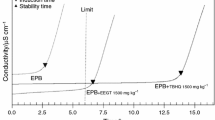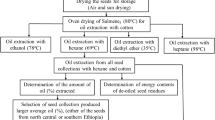Abstract
Jatropha curcas seeds are rich in oil (28–32%), which can be converted to high quality biodiesel. The oil is non-edible due to the presence of toxic compounds, namely, phorbol esters (PEs). PEs have a number of agricultural/medicinal/pharmaceutical applications and hence their recovery generates a value added co-product towards the biodiesel production chain. This study aims to assess the effects of PE extraction on quality of both the residual oil and the biodiesel production from it. Two Approaches (1, use of an Ultra-turrax; and 2, use of a magnetic stirrer) were used with an effective treatment time of 2 and 5 min, resulting in 80 and 78% extraction of PEs, respectively. The phosphorus content was reduced by 70.2 and 75.8%, free fatty acids by 55.3 and 55.6%, and the fatty acid composition did not change in the residual oils. The peroxide value increased from 2.69 (untreated oil) to 3.01 and 3.49 mequiv O2/kg in the residual oils following Approach 1 and Approach 2, respectively. The biodiesel prepared from both residual oils met European (EN 14214:2008) and American biodiesel standard (ASTM D6751-09) specifications. Oxidative stability indices for both the biodiesels were well within the permitted limit. It is concluded that PEs could be isolated in active forms for various applications by either of the two methods with a high yield and the residual oil can be processed to produce high quality biodiesel.

Similar content being viewed by others
References
Makkar HPS, Aderibigbe AO, Becker K (1998) Comparative evaluation of non-toxic and toxic varieties of Jatropha curcas for chemical composition, digestibility, protein degradability and toxic factors. Food Chem 62(2):207–215
Makkar HPS, Becker K, Sporer F, Wink M (1997) Studies on nutritive potential and toxic constituents of different provenances of Jatropha curcas. J Agric Food Chem 45:3152–3157
Makkar HPS, Becker K, Schmook B (1998) Edible provenances of Jatropha curcas from Quintana Roo state of Mexico and effect of roasting on antinutrient and toxic factors in seeds. Plant Food Hum Nutr 52:31–36
Devappa RK, Bhagya S (2008) Biochemical and nutritional evaluation of Jatropha protein isolate prepared by steam injection heating for reduction of toxic and antinutritional factors. J Sci Food Agric 88:911–919
Becker K, Makkar HPS (2008) Jatropha curcas: a potential source for tomorrow’s oil and biodiesel. Lipid Technol 20:104–107
Makkar HPS, Becker K (2009) Challenges and opportunities for using byproducts from the production of biodiesel from Jatropha oil as livestock feed. Proceedings of Animal Nutrition Association World Conference (14–17 Feb). New Delhi. pp 168–170
Devappa RK, Darukeshwara J, Rathina Raj K, Narasimhamurthy K, Saibaba P, Bhagya S (2008) Toxicity studies of detoxified Jatropha meal (Jatropha curcas) in rats. Food Chem Toxicol 46(12):3621–3625
Makkar HPS, Becker K (2009) Jatropha curcas, a promising crop for the generation of biodiesel and value-added coproducts. Eur J Lipid Sci Technol 111:773–787
Li CY, Devappa RK, Liu JX, Makkar HPS, Becker K (2010) Toxicity of Jatropha curcas phorbol esters in mice. Food Chem Toxicol 48(2):620–625
Solsoloy AD, Solsoloy TS (1997) Pesticidal efficacy of formulated J. curcas oil on pests of selected field crops. In: Gübitz GM, Mittelbach M, Trabi M (eds) Biofuels and industrial products from Jatropha curcas. DBV, Graz, pp 216–226
Goel G, Makkar HPS, Francis G, Becker K (2007) Phorbol esters: structure, biological activity and toxicity in animals. Int J Toxicol 26:279–288
Balandrin MF, Klocke JA, Wurtele ES, Bollinger WH (1985) Natural plant chemicals: sources of industrial and medicinal materials. Science 228:1154–1160
Devappa RK, Maes J, Makkar HPS, Greyt WD, Becker K (2009) Isolation of phorbol esters from Jatropha curcas oil and quality of produced biodiesel. 2nd International Congress on Biodiesel: the science and the technologies, Munich, Germany
Makkar HPS, Maes J, De Greyt W, Becker K (2009) Removal and degradation of phorbol esters during pre-treatment and transesterification of Jatropha curcas oil. J Am Oil Chem Soc 86:173–181
AOCS (1990) Official methods and recommended practices of the American Oil Chemists Society, 4th edn. AOCS Press, Champaign
Makkar HPS, Siddhuraju P, Becker K (2007) A laboratory manual on quantification of plant secondary metabolites. Humana press, New Jersey, p 130
Tate RE, Watts KC, Allen CAW, Wilkie KI (2006) The viscosities of three biodiesel fuels at temperatures up to 300 °C. Fuel 85:1005–1010
Mittelbach M (1996) Diesel fuel derived from vegetable oils, VI: specifications and quality control of biodiesel. Bioresour Technol 56:7–11
Mittelbach M (2000) Chemische und motortechnische Untersuchungen der Ursachen der Einspritzpumpenverklebung bei Biodieselbetrieb; Bund-Bundesländer-kooperations-projekt
Meher LC, Sagar DV, Naik SN (2004) Technical aspects of biodiesel production by transesterification: a review. Renew Sust Energy Rev 3:1–21
ASTM (American Society for Testing and Materials) (2008) Standard specification for biodiesel fuel blend stock (B100) for middle distillate fuels, ASTM D6751-09. In: ASTM Annual Book of Standards. American Society for Testing and Materials, West Conshohocken. http://www.astm.org)
European Committee for Standardization (CEN) (2008) Automotive fuels fatty acid methyl esters (FAME) for diesel engines requirement methods EN 14214:2008. European Committee for Standardization (CEN), Brussels
Devappa RK, Makkar HPS, Becker K (2009) Fate of Jatropha curcas phorbol esters in soil. 13th Annual green chemistry and engineering conference, Washington DC. (available at: http://acs.confex.com/acs/green09/webprogram/Paper69396.html)
Acknowledgments
The authors are grateful to the Bundesministerium für Bildung und Forschung (BMBF), Berlin, Germany for financial assistance. The technical assistance of Mr. Hermann Baumgartner is also acknowledged.
Author information
Authors and Affiliations
Corresponding author
About this article
Cite this article
Devappa, R.K., Maes, J., Makkar, H.P.S. et al. Quality of Biodiesel Prepared from Phorbol Ester Extracted Jatropha curcas Oil. J Am Oil Chem Soc 87, 697–704 (2010). https://doi.org/10.1007/s11746-010-1547-4
Received:
Revised:
Accepted:
Published:
Issue Date:
DOI: https://doi.org/10.1007/s11746-010-1547-4




